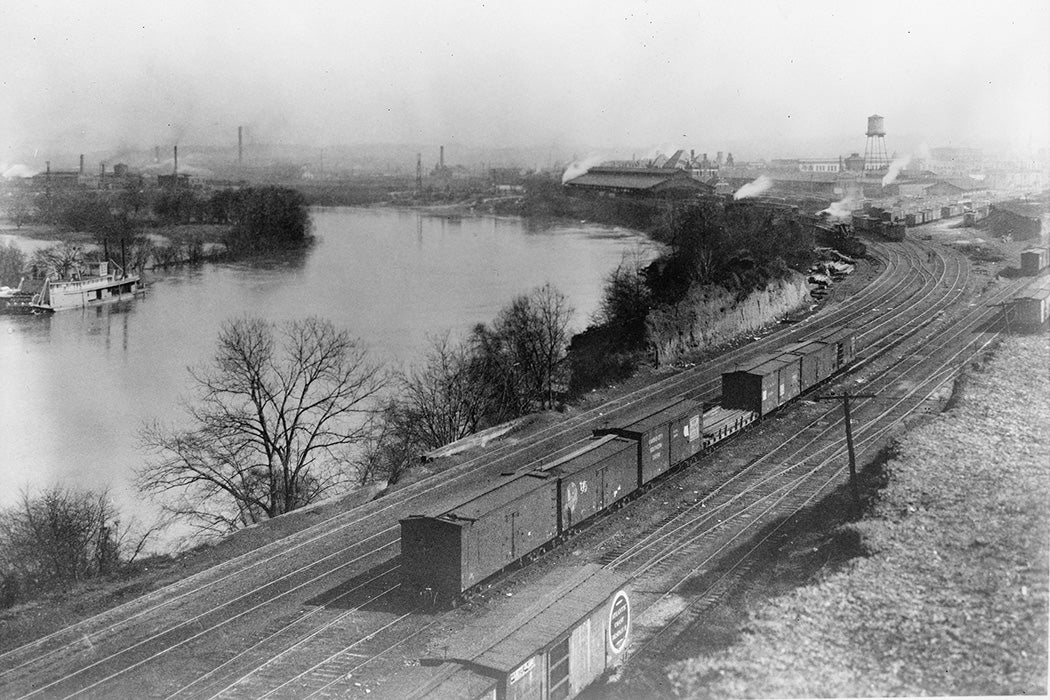His name was Morris Slater, but he was better known as “Railroad Bill.” That’s the kind of name about which they write ballads, the kind of name that starts incredible stories: “Did you hear about Railroad Bill?” That was true for Slater, too. But his legacy as “an outlaw,” that infamous figure who ran up and down the American timeline, is a complex one. Railroad Bill differed from other outlaws because he was Black, and his race—and perceptions of it—intersected with a volatile time in US history. As historian Burgin Mathews explains, Railroad Bill represented a “powerful individual threat to white authority.”
But let’s go back. The legend started somewhere, and for Railroad Bill it began in Alabama around 1893. Slater, as he was still known, was a turpentine still worker. As the story goes, one day he strolled into town with a rifle. He was approached by a policeman and asked to turn over his gun. The request, according to some versions of the story, came because Slater had refused to pay taxes on the gun. There was a struggle. Bullets flew. Slater shot the officer, then fled, escaping either to the swamps or by hopping on a passing freight train. From that day on, he’d be known as Railroad Bill.
As folklorist John W. Roberts explains, the legend of Railroad Bill had all the hallmarks of a classic outlaw/folk hero. The American outlaw is, “seen as a man of the people,” Roberts writes. “Much of his reputation is based on the perception of the outlaw as one who rights wrongs.”
When Bill hopped onto that train and into the folk imagination, Black folklore often portrayed him in such a light. He robbed trains throughout the state, having shootouts and evading capture, and not only did he sell the stolen goods to poor Black people at prices lower than company stores, his acts, though not condoned, were seen as “defiance against the white system and celebration of his ‘badness,’” Roberts writes.
Bill always stayed one step ahead of the police, and these weren’t the times for a Black person to outwit white authority. The effects and attitudes of Reconstruction still lingered, and Jim Crow laws were multiplying in number and strength. Alabama, like all of the South, “struggled to adjust to a new racial as well as economic order,” according to Mathews. Bill’s crimes only deepened the belief that newly-emancipated Black Americans needed to be controlled. Because of this, the hunt for Railroad Bill extended far past the outlaw himself.
Newspapers of the time peppered stories of his exploits with slurs and other dehumanizing language, “his color merging with an almost inhuman evil,” Mathews explains. Some reports went as far as to suggest that Bill could change into an animal, and that’s why he was so difficult to catch. This would only intensify on July 3, 1895, when Bill killed a sheriff in a shootout. He, once again, escaped capture. From this point, Mathews asserts, “the legend of Railroad Bill became a stage on which the white South enacted its bloody drama of race, identity, and power.”
With an ever-increasing award for his capture, no Black person was safe. Men and women across southern Alabama and Florida were arrested: because they were suspected of being Bill or of harboring him, or because someone believed that they had information about him. One man was arrested several times on suspicion of being Bill, and several others were shot because they supposedly matched Bill’s description. As one newspaper reported, “The number of negroes who were killed under the impression that they were Slater will never be known.”
Weekly Newsletter
As for the real Railroad Bill, he was ultimately killed on March 7, 1896, inside a store in Atmore, Alabama. He was shot fifteen times, but the medical examiner noted that the first shot fired was the fatal one. Matthews notes that the white press reports were generally filled with “the spirit of celebration.” In one town, his body was put on display in an empty freight car for four days, the morbidly curious charged twenty-five cents admission. Souvenir photos were put on sale for fifty cents. As Mathews writes, “the mutilated remains of Railroad Bill, one hand mangled and face ripped open, toured train stations…throughout south Alabama and into Florida.” He was finally buried in an unmarked grave in Florida.
But outlaws and their legends live on. Despite the macabre display, some doubted the body was Bill’s. He was still alive, they insisted, roaming the Alabama woods in animal form. But in a way, he does live on: there have been various ballads retelling his story—by white and Black singers—written as late as the 1980s. “In the Railroad Bill songs,” Matthews writes, “it is most often not Bill’s historical actions but the persona of the badman that is remembered and celebrated.”
Editor’s note: This article was amended to clarify that the events described took place after the Reconstruction ended in 1877.
Support JSTOR Daily! Join our new membership program on Patreon today.







